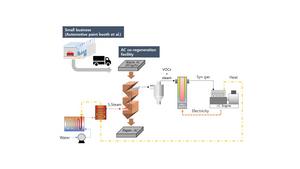Dr. Dong Hyuk Chun and his research team from the Clean Air Research Laboratory of the Korea Institute of Energy Research (Kier) Under the direction of President Chang-Keun Yi have developed a technology that efficiently manages volatile organic compounds (VOCs) and recycled them with lower energy consumption compared to existing methods. Remarkably, this technology can be applied to company companies in and around cities, which significantly reduces the burden for companies caused by emission regulations.
Vocs, which include carcinogenic substances such as benzene, are mainly generated from color, new furniture and industrial processes that contribute to fine dust and unpleasant smells. To remove these pollutants, frequently activated carbon is used, which is known for its air -proof effects. In particular, the regulations stipulate that small companies that emit 10 tons or more air pollutants per year have an activated carbon to combat voc emissions.
Companies that are often included in cities are also subject to the regulations if their furnishing variable exceeds approximately 400 square meters. According to these regulations, such companies must install monitoring sensors in pollution tax devices that consist of filters and activated carbon and manage their operation in real time. However, VOC sensors are expensive, so that companies are only dependent on current and differential pressure sensors. Without measuring the VOC concentrations, it is difficult to properly manage the pollution. As a result, small companies that are burdened by the costs have difficulties taking effective measures.
In response to this, the research team developed a technology with which the replacement cycle of activated carbon can also be determined with inexpensive sensors and a method for regeneration of activated carbon. This innovation has successfully reduced the replacement costs for small businesses to around half of the price of new activated carbon.
The research team developed an algorithm, which also enables precise measurements for inexpensive sensors by calculating the difference between VOCS measurements from high-performance sensors and inexpensive sensors and analyzing the environmental conditions, causing these discrepancies with the Kwangwon university. With this algorithm, the measurement accuracy of inexpensive sensors improved to 92%and made it possible to determine the optimal replacement cycle without relying on high -performance sensors.
The research team dealt with the high costs for the exchange of activities through the development of recycling technology, which was specially developed for air purification applications. Activated carbon is generally divided into two species: one for water cleaning and the other for air purification. Although both types are typically regenerated by high -temperature warming in order to remove adsorbed substances, water cleaning requires carbon up to 1,000 ° C, while the carbon of air purification can be regenerated at only 200 ° C. Due to the lack of specialized facilities for the recycling of air purification carbon, companies had to rely on cost -effective facilities for water cleaning carbon, which led to considerable heating costs.
In contrast, the research team successfully developed a specialized 200 ° C system for regeneration of carbon with air supply, which reduces the consumption of the process by over 70% compared to conventional methods. This newly developed system eliminates VOCs by providing steam and continuously moving the activated carbon. The regenerated activated carbon retains 90% of its original performance, which reusable it for companies.
Remarkably, a certain amount of synthetic gas is generated during the removal of VOCs, with which a generator is supplied with electricity and generated electricity. The current generated is then fed back into the process in order to reduce both the recycling costs and the costs incurred by companies. The research team predicts that if several small businesses share the newly developed facility, reduce the costs for the activated carbon substitute to approximately half of the price for newly activated carbon.
In addition, the research team develops a method for the production of hydrogen, an environmentally friendly energy source using VOCs. Currently, VOCs are usually burned to disposal, which leads to the emission of carbon dioxide, a greenhouse gas. In order to address this problem, the researchers want to reform the hydrocarbons in vocs in hydrogen and carbon monoxide, creating a sustainable process that reduces carbon emissions during the entire recycling cycle.
Dr. Dong Hyuk Chun from Kier, who headed research, explained: “This study is important in that it effectively manages VOC emissions from small companies, reduces operating costs by regeneration used activated carbon and realized the energy tests of waste gases such as VOCs.” He also emphasized: “In the future, this technology will contribute to the expansion of environmentally friendly public management systems and to implement carbon neutrality.”
In the meantime, this research was carried out with the support of the project of the Environment Ministry for intelligent optimization and management technology to reduce dust at industrial locations. The results were published in October 2024 in the internationally known journal online Energy conversion and management: X.
Liability exclusion: Aaas and Eurekalert! are not responsible for the accuracy of news publications published in Eurekalert! through contributions from institutions or the use of information about the Eurekalert system.
